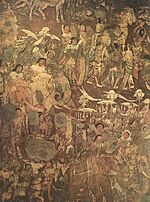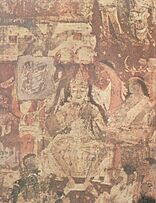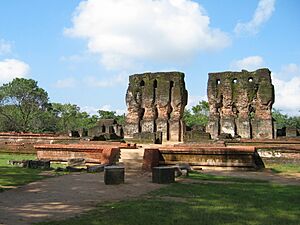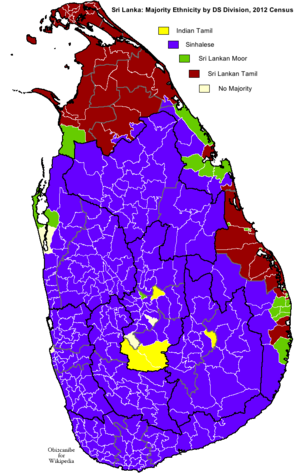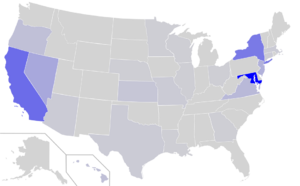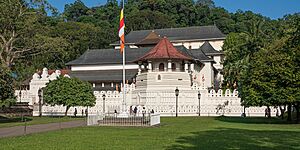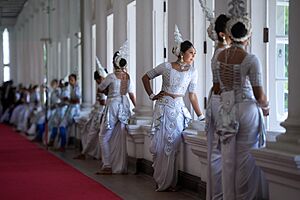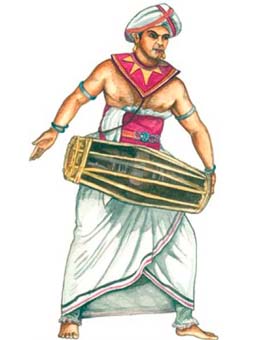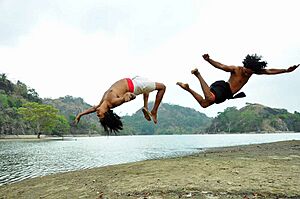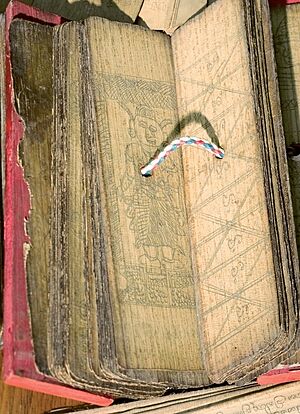Sinhalese people facts for kids
| සිංහල ජනතාව | |
|---|---|
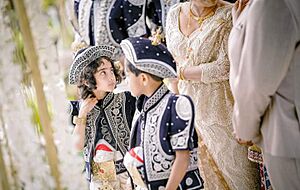
Sinhalese children in folk costume
|
|
| Total population | |
| c. 17 million | |
| Regions with significant populations | |
| 15.2 million (74.9%) (2012) | |
| 108,069 (2022) | |
| 58,166 (2021) | |
| ~41,000 (2016) | |
| 33,050 (2021) | |
| ~17,000 | |
| 14,731 (2021) | |
| 9,171 (2018) | |
| ~5,300 | |
| ~4,700 | |
| Languages | |
| Sinhala | |
| Religion | |
| Majority: Minority: |
|
| Related ethnic groups | |
|
|
The Sinhalese people (Sinhala: සිංහල ජනතාව, romanized: Sinhala Janathāva) are an ethnic group from the island nation of Sri Lanka. They are the largest group in Sri Lanka, making up about 75% of the population. There are more than 15.2 million Sinhalese people.
Sinhalese people speak Sinhala, which is an Indo-Aryan language. Most Sinhalese people follow Theravada Buddhism. A smaller number of Sinhalese people are Christians or follow other religions. Since 1815, Sinhalese people have been divided into two main groups:
- The up-country Sinhalese, who live in the central mountains.
- The low-country Sinhalese, who live near the coast.
Both groups speak Sinhala, but they have some different cultural customs.
According to the Mahavamsa, an ancient book written by Buddhist monks, the Sinhalese people came from settlers. These settlers arrived around 543 BCE from a place called Sinhapura. They were led by Prince Vijaya and mixed with later settlers.
The Name "Sinhala"
The word "Sinhala" has a few possible meanings. One idea is that it comes from sinha (සිංහ), meaning "lion", and la (ල), meaning "slayer" or "taker". So, Sinhala could mean "lion-slayer".
This story is told in the Mahāvaṃsa. It connects to the founding legend of Sri Lanka. The legend says the island was settled by a descendant of Sinhabahu. Sinhabahu is said to have killed his father, who was a lion.
According to the legend, a princess named Suppadevi had a son, Sinhabahu, with a lion. The Mahāvaṃsa says that because Sinhabahu killed the lion, his children and their descendants were called 'Síhala' (the lion-slayers). Because his descendants settled Sri Lanka, the island also became known as 'Sinhala'.
The first king of Sri Lanka, Prince Vijaya, was the son of Sinhabahu. Some stories say Vijaya was Sinhabahu's grandson. King Vijaya arrived on the island of Tambapanni (Sri Lanka) and started the Sinhalese people. A painting in the Ajanta Caves (Cave No 17) shows the story of Prince Vijaya's arrival.
Another idea is that Sinhabahu's descendants were called "Sinha" (lions) because they were brave. Then, those who settled Sri Lanka were called Sinhala, meaning "people of the lion". The land they settled might have been called 'Sinhalaya' or 'Sinhalé', and their language 'Sinhala'.
History of the Sinhalese People
The early history of the Sinhalese is found in two important documents:
- The Mahavamsa, written around the 4th century CE.
- The Culavamsa, started around the 13th century CE.
These ancient books tell the stories of the powerful Sinhalese kingdoms of Anuradhapura and Polonnaruwa. These kingdoms lasted for about 1500 years. The Mahavamsa describes rice fields and water reservoirs, showing that the Sinhalese had a well-developed farming society.
2 The crowning of King Sinhala (Prince Vijaya) from the Ajanta Caves Mural.
| Historical population | ||
|---|---|---|
| Year | Pop. | ±% |
| 1881 | 1,846,600 | — |
| 1891 | 2,041,200 | +10.5% |
| 1901 | 2,330,800 | +14.2% |
| 1911 | 2,715,500 | +16.5% |
| 1921 | 3,016,200 | +11.1% |
| 1931 | 3,473,000 | +15.1% |
| 1946 | 4,620,500 | +33.0% |
| 1953 | 5,616,700 | +21.6% |
| 1963 | 7,512,900 | +33.8% |
| 1971 | 9,131,300 | +21.5% |
| 1981 | 10,979,400 | +20.2% |
| 1989 (est.) | 12,437,000 | +13.3% |
| 2001 | 13,876,200 | +11.6% |
| 2011 | 15,173,820 | +9.4% |
| 2001 Census was only carried out in 18 of the 25 districts. Source:Department of Census & Statistics, Sri Lanka & Statistics Data is based on Sri Lankan Government Census. |
||
Early Kingdoms Period
According to the Mahavamsa, Prince Vijaya and his 700 followers arrived on the island. They landed near modern-day Puttalam and founded the Kingdom of Tambapanni. This happened on the day of Buddha's Parinirvana. Tambapanni became the capital, and soon the whole island was known by this name.
After Vijaya's rule, his minister Upatissa became regent for a year. Later, Vijaya's nephew, Panduvasdeva, came from India to rule.
Anuradhapura Kingdom
In 377 BC, King Pandukabhaya moved the capital to Anuradhapura. He made it a rich and successful city. Anuradhapura was named after a minister and also after an auspicious star. It remained the capital for many kings.
Kings like Dutthagamani, Valagamba, and Dhatusena were famous for fighting invaders and taking back control of the kingdom. Other kings, like Gajabahu I, also fought against invaders.
Polonnaruwa Kingdom
During the Middle Ages, Sri Lanka was known for its great farming success. This was especially true under King Parakramabahu in Polonnaruwa. During his time, the island was called the "rice mill of the east" because it produced so much rice.
Later Kingdoms and European Influence
Later, in the 13th century, the country was divided into smaller kingdoms. These included the Kingdom of Sitawaka, Kingdom of Kotte, Jaffna Kingdom, and the Kandyan kingdom. An invasion by King Magha in the 13th century caused many Buddhists (mostly Sinhalese) to move to areas he did not control.
Later, King Parakramabahu VI of Kotte conquered the Jaffna Kingdom. This brought the whole country under Sinhalese rule for 17 years. Trade also grew, and many Muslim traders came to the island.
In the 15th century, the Kandyan Kingdom formed. This divided the Sinhalese people into "low-country" and "up-country" groups. During this time, new Sinhalese caste groups appeared, influenced by Hindu immigrants from South India.
Sinhalese Society
Where Sinhalese People Live
Most Sinhalese people in Sri Lanka live in the South, Central, Sabaragamuwa, and Western parts of the country. Cities like Hambantota, Galle, Gampaha, Kurunegala, Monaragala, Anuradhapura, and Polonnaruwa have more than 90% Sinhalese population.
| Province | Sinhalese people |
% Sinhalese population of the province |
% Provincial contribution to total population |
|---|---|---|---|
| 1,687,199 | 66.00% | 11.11% | |
| 359,136 | 23.15% | 2.36% | |
| 32,331 | 3.05% | 0.21% | |
| 1,143,607 | 90.90% | 7.53% | |
| 2,030,370 | 85.70% | 13.38% | |
| 1,657,967 | 86.40% | 10.92% | |
| 2,340,693 | 94.96% | 15.42% | |
| 1,017,092 | 80.80% | 6.70% | |
| 4,905,425 | 84.26% | 32.32% | |
| Total | 15,173,820 | 74.80% | 100.00% |
Sinhalese Around the World
Many Sinhalese people have moved to other countries. Large communities live in the United Kingdom, Australia, the United States, and Canada. Many Sinhalese also work or study temporarily in the Middle East, Southeast Asia, and Europe.
The biggest Sinhalese communities outside Sri Lanka are in Europe, North America, and Australia. For example, nearly half of all Sri Lankan Australians live in Melbourne. In 2006, about 73,849 Australians said they had Sinhalese ancestry.
In the 2011 Canadian Census, 7,220 people identified as having Sinhalese ancestry. In the U.S., about 12,000 people are Sinhalese. The New York City Metropolitan Area has the largest Sri Lankan community in the United States.
Many Sinhalese have moved to Italy since the 1970s, looking for work. It is estimated that 30,000–33,000 Sinhalese live in Italy. Major communities are in Lombardia, Milan, Lazio, Rome, Naples, and Southern Italy.
Language and Literature
Sinhalese people speak Sinhala, also called "Helabasa". This language has two forms: spoken and written. Sinhala is an Indo-Aryan language, part of the larger Indo-European languages family. The first form of the language came to Sri Lanka with the ancestors of the Sinhalese people from northern India.
Sinhala developed differently from other Indo-Aryan languages because it was geographically separated. It was influenced by Pali (a sacred Buddhist language), Telugu, and Sanskrit. Many old Sinhala texts, like the Hela Atuwa, were lost after being translated into Pali. Other important Sinhala books include Amāvatura and Jathaka Potha.
Sinhala has also borrowed words from other languages. These include Tamil and European languages like Portuguese, Dutch, and English. Today, some English words are used because of British rule and foreign films.
Many Sinhalese people also speak English or Tamil. According to the 2012 Census, about 23.8% of Sinhalese people spoke English, and 6.4% spoke Tamil.
Old folk tales like Mahadana Muttha saha Golayo and Kawate Andare are still enjoyed by children today. Mahadana Muttha is about a foolish scholar who travels around and causes trouble. Kawate Andare tells the story of a clever court jester.
In modern times, Sinhala writers like Martin Wickremasinghe and G. B. Senanayake are well-known. Martin Wickramasinghe wrote the popular children's novel Madol Duwa. Munadasa Cumaratunga's Hath Pana is also very famous.
Religion and Beliefs
The main form of Buddhism in Sri Lanka is Theravada Buddhism. Ancient texts say that the Sinhalese people are meant to protect Buddhism. In 1988, almost 93% of Sinhala-speaking people in Sri Lanka were Buddhist.
Sinhalese Buddhists often blend their practices with elements from Hindu traditions. They may worship Hindu gods and goddesses, or use ancient beliefs about spirits. For example, Kataragama deviyo (from Kartikeya) and Upulvan (from Vishnu) are worshipped.
During British rule, a type of Buddhism called "Protestant Buddhism" appeared. This was a response to Christian missionaries. Buddhists started their own schools and organizations, like the Young Men's Buddhist Association, to defend Buddhism.
Christianity Among Sinhalese
There is a notable Sinhalese Christian community, especially in the coastal areas. Christianity came to the Sinhalese through Portuguese, Dutch, and British missionaries. Most Sinhalese Christians are Roman Catholic, while a smaller number are Protestant. Their cultural center is Negombo.
Religion is very important to the Sinhalese people. A 2008 survey found that 99% of Sri Lankans felt religion was an important part of their daily lives.
Culture of the Sinhalese People

Sinhalese culture is very old, going back about 2600 years. It has been greatly shaped by Theravada Buddhism. Key parts of the culture include sculpture, fine arts, literature, dancing, poetry, and many folk beliefs and rituals.
Ancient Sinhala stone sculptures and inscriptions are famous worldwide. Sigiriya is known for its beautiful wall paintings called frescoes. Folk poems were sung by workers to help them with their tasks and tell stories about their lives. These poems usually had four lines and special rhyming patterns.
Buddhist festivals feature unique music played on traditional Sinhalese instruments. Older rituals, like tovils (devil exorcism), are still performed. These rituals often ask for the good powers of the Buddha and gods to get rid of bad spirits.
Traditional Dress
Traditionally, Sinhalese men wear a sarong (called sarama in Sinhala) for everyday activities. They might wear a long-sleeved shirt with it.
For women, clothing varies by region:
- Low-country Sinhalese women wear a white, long-sleeved jacket and a tight wrap-around skirt, often with floral designs.
- Up-country Sinhalese women wear a similar outfit, but with a puffed-up shoulder jacket and a frill tucked into the top of the skirt (called Reda and Hatte).
- Traditionally, high-caste Kandyan women wear a Kandyan-style sari, also called an Osariya. It has a drape and a frill lining the bottom.
- Low-country high-caste women wear a South Indian style saree.
In more populated areas, Sinhalese men also wear Western clothes like suits. Women wear skirts and blouses. For formal events, women often wear the traditional Kandyan (Osariya) style. This includes a full blouse that covers the midriff. The Kandyan style is considered the national dress for Sinhalese women. The saree is also very important and is often worn by female office workers, especially in government jobs.
Delicious Cuisine
Sinhalese cuisine is one of the most complex in South Asia. It has been influenced by colonial powers and foreign traders. Rice is eaten daily and is part of every meal. Spicy curries are popular for lunch and dinner. Some Sri Lankan dishes are similar to those from Kerala in India.
A well-known rice dish is Kiribath, which means 'milk rice'. Besides sambols, Sinhalese people eat mallung, which are chopped leaves mixed with grated coconut and red onions. Coconut milk is used in most Sri Lankan dishes to give them a special flavor.
Sri Lanka is famous for its spices, especially cinnamon, which grows there naturally. In the 15th and 16th centuries, spice traders brought their own cooking styles to the island. This led to a rich variety of dishes.
Lamprais is a Dutch-influenced Sri Lankan dish. It has rice boiled in stock with a special curry and meatballs. All of this is wrapped in a banana leaf and baked. Dutch and Portuguese sweets are also still popular. British influences include roast beef and roast chicken. Indian cooking methods have also greatly shaped what Sri Lankans eat.
The main meal usually includes boiled or steamed rice with curry. This often features a main curry of fish or chicken, along with other curries made from vegetables, lentils, or even fruit. Side dishes include pickles, chutneys, and sambols. The most famous is the coconut sambol. It is made from ground coconut mixed with chili peppers, dried Maldives fish, and lime juice. This paste is eaten with rice to add flavor and is thought to make you hungrier.
Art and Architecture
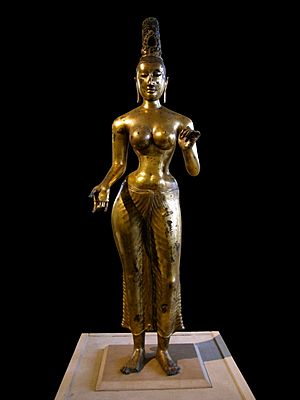
Many forms of Sri Lankan arts and crafts are inspired by the island's long-standing Buddhist culture. This culture has also taken in many regional and local traditions. Most Sri Lankan art comes from religious beliefs. It can be seen in painting, sculpture, and architecture.
Notable examples of Sri Lankan art include cave and temple paintings. These are like the frescoes at Sigiriya and the religious paintings in temples at Dambulla and the Temple of the Tooth Relic in Kandy. Other popular art forms have been influenced by both local people and outside settlers. For example, traditional wooden crafts and clay pottery are found in the hill country. Portuguese-inspired lacework and Indonesian-inspired Batik have also become well-known.
Sinhalese people developed advanced architectural skills. In the late sixth century BCE, they built amazing structures in kingdoms like Anuradhapura and Polonnaruwa. Examples include Ruwanwelisaya, Jetavanaramaya (the second tallest brick building in the ancient world), and Abayagiriya (the third tallest).
They also had unique ancient water technology. They built large tanks, ponds with fountains, moats, and irrigation reservoirs like Parakrama Samudra, Kaudulla, and Kandalama. Sigiriya is often called the eighth wonder of the world. It is a mix of natural and man-made fortress, with many amazing architectural features.
Music and Performing Arts
There are many folk poems related to specific jobs in ancient Sinhalese society. These were communal songs with a rhythm, sung while doing daily tasks like harvesting.
In popular music, Ananda Samarakoon created the Sarala gee style in the late 1930s. He was followed by famous artists like Sunil Shantha and W. D. Amaradeva.
Dramatist Ediriweera Sarachchandra brought new life to drama with Maname in 1956. In the same year, film director Lester James Peries made the artistic film Rekava. This film aimed to create a unique Sinhalese cinema. Since then, Peries and other directors have developed artistic Sinhalese films. Sinhala cinema often includes songs and dances, making it unique.
Recent high-budget films like Aloko Udapadi and Maharaja Gemunu are based on Sinhalese epic historical stories. They have been very successful.
The performing arts of the Sinhalese people include:
- Kandyan dance: This dance has 18 Wannam (dance routines) that show the movements of animals like elephants, eagles, and peacocks. They are mainly performed in the annual Perahara pageant at the Temple of the Tooth in Kandy.
- Pahatharata dance: This style is used to cure illnesses and for spiritual cleansing. Dancers wear masks of gods and demons and use fire and water to bless people.
- Sabaragamuwa dances: These dances are mainly for entertainment.
- Folk music and dances: These vary by caste and region. They are popular among children, especially girls, and are often performed during the Sinhalese New Year.
Martial Arts
Angampora is the traditional martial art of the Sinhalese people. It combines combat techniques, self-defence, and meditation. Key techniques include:
- Angam: Hand-to-hand fighting.
- Illangam: Using traditional weapons like Velayudaya (a flexible sword), staves, knives, and swords.
A special feature is using pressure point attacks to cause pain or paralyze an opponent. Fighters use both striking and grappling moves. Angampora almost disappeared after the British took over Sri Lanka in 1815. However, it survived in a few families until the country became independent again.
Education and Medicine
The Sinhalese have a long history of learning. Buddhist Monks taught basic reading and writing even before the birth of Christ. This traditional system focused on Buddhist understanding. Officials were also trained to keep records for the government.
Technical skills, like building reservoirs and canals, were passed down through families and apprenticeships.
When the Portuguese and Dutch arrived, religion remained central to education. Later, in the 1800s, the British worked to improve education. Christian missionary groups helped a lot, leading to high literacy among Christians.
By 1901, schools in the South and North were well-developed. However, inner regions lagged behind. English education was also difficult for many people to access due to fees.
Traditional Sinhalese villages used to have at least one main medical person called a Weda Mahaththaya (Doctor). These doctors passed down their medical knowledge through their families. Sinhalese Medicine is similar to Ayurveda. For some treatments, they use Buddhist chants (Pirith) to make the medicine more effective.
According to the Mahavamsa, King Pandukabhaya of Sri Lanka (437–367 BC) built lying-in homes and Ayurvedic hospitals (Sivikasotthi-Sala). This is one of the earliest records of places specifically for caring for the sick anywhere in the world. Mihintale Hospital is considered the oldest hospital in the world.
Images for kids
See also
 In Spanish: Cingalés para niños
In Spanish: Cingalés para niños
- List of Sinhalese people
- Dewa people of Sri Lanka


